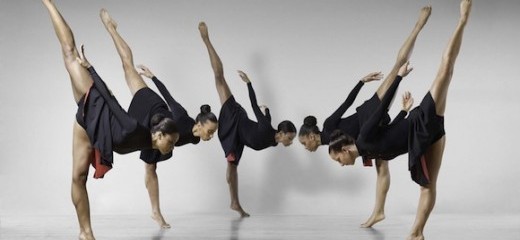
Photo: Lois Greenfield
They DANCE!
by Carolyn Merritt
I should begin with a confession. Before last night, I had yet to see Philadanco, though I’ve lived eleven years in Philadelphia. (Minus three for travel and research, but still.) Had I assumed I knew what I would see? That others needed my support more so I needn’t bother? I’m not sure anything could have prepared me for the experience. Currently in their 44
th season, Philadanco presented their annual winter concert at the Kimmel Center, where they have been resident modern dance company since 2000. A celebration of Alvin Ailey alum and master teacher Christopher Huggins’ choreography, the evening was also a showcase of the company’s technical wizardry and stamina, an hour and a half of “balls to the wall” dancing rooted in African American, contemporary ballet, and modern influences. While I can’t gauge whether they are the
"the most versatile dance company in Philadelphia," they are arguably one of the city's most jaw-dropping ensembles of technicians.
The most theatrical work, The List probes a Jewish family’s summons to a Krakow ghetto. A loud knock disturbs a family of four seated for dinner. An ominous offstage presence hands papers to the father figure, played by Tommie-Waheed Evans. Cue the sad violins, and the kinesthetic response begins. Father, mother and daughters shake fists, rhythmically slam and rotate elbows and forearms on table, and play an elegant rendition of musical chairs. From small bags, they extract and don white armbands, then collapse to the table. With Roxanne Lyst as the mother, Evans displays axes of rotation in flexed hand/ knee/ foot lifts, and rises through her parted legs so that she rests like a new Jewish bride on his shoulders. A chilling chorus and a steely soprano serve as backdrop to duets of love, support, grief, fear, each an occasion to display exquisite extensions, perfect triple pirouettes, rippling accentuations of limbs, full-body propulsions from elbows and back.
An examination of manhood, Blue is revelatory for its layered portraits of black male bodies. Emerging first in flowing blue tunics and pants, the eight male dancers move and partner with a sweet vulnerability bordering on feminine, only to shed their tops and evolve into aggressive/ protective warriors before our eyes. When a lone male dancer leaps sacrificially offstage into unseen arms, I gasp aloud as the audience bursts into thunderous applause.
When Dawn Comes begins and ends with four sleeping nymphs center stage. They awake alone, dazzling with weightless jumps, powder-puff delicate ballonés, crouched shuffles that mimic tickled ivories. Greeted by four men in skivvies, they leap into their arms, extend legs sideways into straddle and slowly retract through butterfly position, hovering above the floor. Jennifer Jones and Cain Coleman explore in/dependence: she throws her limbs round whatever body part she can, and he simply carries on with the added burden, shaking her loose time and again. In the partnering that ensues, Huggins introduces signature tricks: cartwheels on elbows and en l’air, oversplits, shoulder rolls that end in impossibly high back arabesques from the floor.
This continues in the second half, notably in The Big Bang, which begins and ends with the group clumped center stage under a bright searchlight that evokes UFO more than creation, and Enemy at the Gates, a quasi-fascist exploration of “enemies within.” In the first, Rosita Adamo swings her leg from a deep back penché, and her partner grabs her toe to lift that same leg front, a full 360 degrees in reverse. Another tosses one of the women in the air, nestles her seat on his shoulders, her back to the back of his head, and carries her offstage with no support save his perfectly erect posture. In Enemy, Huggins advances the pace to lightning-quick, and the dancers move so rapidly through so many awe-inspiring moves (many familiar by now), the notion of transitions utterly disappears and I can no longer register everything unfolding before me.
It is tempting to fault Huggins’ reliance on crowd-pleasing feats. One audience member enthusiastically shouted “You DANCE!” several times during the show. Indeed, they danced as if their lives depended on it, and the movement – non-stop, virtuosic and spectacular – demanded this. More irksome were choreographic tendencies like neat bookends, largely heteronormative couplings, repeat tricks in distinct storylines, musical interpretation bordering on Disneyesque, and yearning “modern dance” faces. But crowd-pleasing has its place in dance, and it would be a shame not to push Philadanco to their limits. Huggins did that, and it was sheer delight to revel in their non-stop, flawless execution. They left me breathless.
Celebrating the Genius of Christopher L. Huggins, Philadanco, Perelman Theater, Kimmel Center, December 6-8.
By Carolyn Merritt
December 12, 2013

